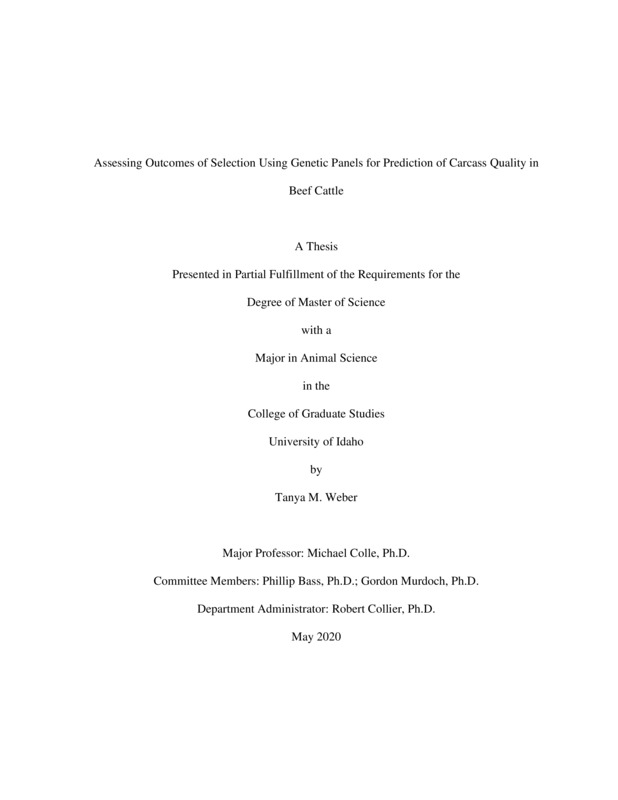Assessing Outcomes of Selection Using Genetic Panels for Prediction of Carcass Quality in Beef Cattle
Weber, Tanya Marie. (2020-05). Assessing Outcomes of Selection Using Genetic Panels for Prediction of Carcass Quality in Beef Cattle. Theses and Dissertations Collection, University of Idaho Library Digital Collections. https://www.lib.uidaho.edu/digital/etd/items/weber_idaho_0089n_11814.html
- Title:
- Assessing Outcomes of Selection Using Genetic Panels for Prediction of Carcass Quality in Beef Cattle
- Author:
- Weber, Tanya Marie
- Date:
- 2020-05
- Embargo Remove Date:
- 2022-08-26
- Keywords:
- beef quality genetic panels Igenity marbling PredicGEN tenderness
- Program:
- Animal and Veterinary Science
- Subject Category:
- Animal sciences
- Abstract:
-
Marbling and tenderness are economically important traits that have been shown to be highly heritable in beef cattle. As a result, genetic panel technology has become available for beef producers to use as a selection tool and has grown in popularity in the beef industry since its validation. Therefore, the objectives of the outlined studies were to 1.) determine whether beef cattle genetically selected for tenderness generated a more tender product, and to 2.) evaluate the effectiveness of genetic panel marbling indexes [Igenity (IT) and PredicGEN (PG)] to predict marbling of crossbred cattle. In the first study, Igenity (IT) panel results were provided by a cattle producer for fifty-two steers. Carcasses from those steers were grouped based upon their IT tenderness index scores. Steaks from boneless strip loins collected from the carcasses were analyzed for Warner-Bratzler shear force (WBSF) and consumer sensory evaluations. In the second study, blood samples from twenty-three steers were submitted for genetic panel analysis, and their carcasses were grouped by IT and PG marbling index scores. Steaks from those carcasses were analyzed for WBSF and a consumer sensory panel. Based on results from the first experiment, the cattle that had been selected to be tender were very tender, suggesting a successful selection outcome. Although all the carcasses attained the USDA Certified Tender threshold (< 4.4kg WBSF), currently few processing plants participate in the USDA Tenderness premium program. This means producers will still benefit the most by separating their cattle based on Marbling Score (MS), which is what is used to determine USDA Quality Grade. Based on results from the second experiment, MS can be predicted using commercially available genetic panels. In conclusion, genetic panels could be a beneficial tool to producers for selection within their herd and for making decisions about retaining ownership at the feedlot.
- Description:
- masters, M.S., Animal and Veterinary Science -- University of Idaho - College of Graduate Studies, 2020-05
- Major Professor:
- Colle, Michael J
- Committee:
- Murdoch, Gordon K; Bass, Phillip D
- Defense Date:
- 2020-05
- Identifier:
- Weber_idaho_0089N_11814
- Type:
- Text
- Format Original:
- Format:
- application/pdf
- Rights:
- In Copyright - Educational Use Permitted. For more information, please contact University of Idaho Library Special Collections and Archives Department at libspec@uidaho.edu.
- Standardized Rights:
- http://rightsstatements.org/vocab/InC-EDU/1.0/

